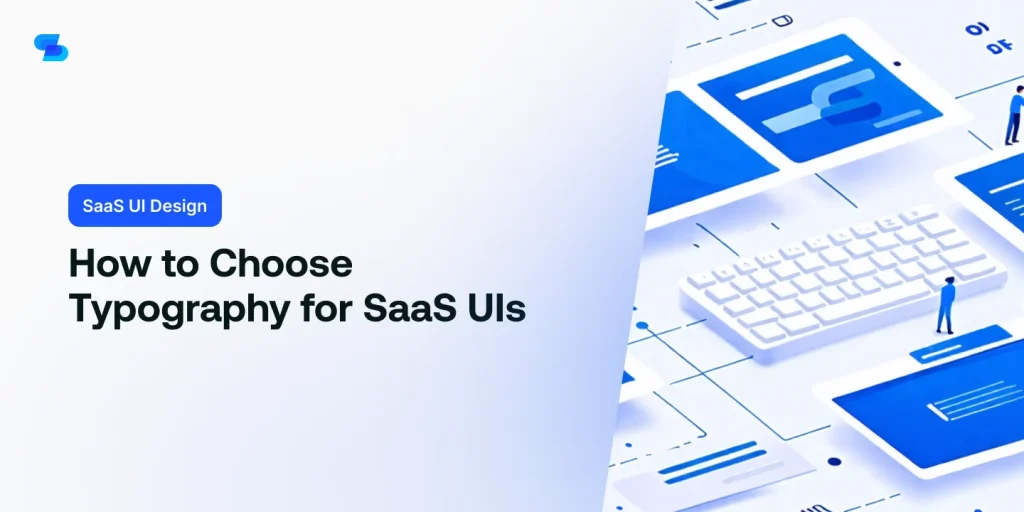When designing a SaaS UI, you’re tasked with choosing typography that strikes a balance between readability, aesthetics, and brand identity. You’ll need to select a few fonts that work harmoniously together, considering factors like serif vs. sans-serif, font sizes, and styles. But that’s just the beginning. You must also guarantee your typography aligns with user goals, accessibility standards, and the overall personality of your brand. By making informed decisions, you can create a visual hierarchy that guides users through your interface. But what specific considerations will make or break your typography choices, and how can you test them effectively?
1. Understanding Typography Basics
You start with the fundamentals by recognizing that typography is an essential aspect of visual communication, comprising seven key elements: typeface, font, size, line spacing, alignment, color, and style. Understanding these elements is vital in creating a visually appealing and effective SaaS UI.
Let’s dive deeper into the basics. Font anatomy refers to the structure of a single character, including the x-height, cap height, and baseline. Familiarizing yourself with font anatomy helps you select fonts that work well together.
Type classifications, such as serif, sans-serif, script, and display, also play a significant role in your typography choices. Serif fonts, like Times New Roman, are ideal for body text, while sans-serif fonts, like Helvetica, are better suited for headings.
Knowing the strengths and weaknesses of each type classification enables you to make informed decisions about your typography. By grasping these fundamental concepts, you’ll be well-equipped to create a harmonious and engaging typography system for your SaaS UI.
2. Considering User Interface Goals
When designing a SaaS UI, contemplate the primary goals and tasks users need to accomplish, and let those objectives inform your typography choices to create an intuitive and seamless user experience. You want to guarantee your typography aligns with user goals, supporting their progress and engagement.
To do this, reflect on the design principles that guide your interface’s overall aesthetic and functionality. Typography should provide clear interface feedback, helping users navigate and interact with your UI efficiently.
It’s crucial to balance user engagement with brand identity, as typography plays a significant role in shaping your brand’s emotional response and cultural implications. Don’t forget to take into account accessibility considerations, such as font sizes and color contrast, to minimize cognitive load and promote inclusivity.
3. Selecting Fonts for Readability
Frequently, the most critical aspect of selecting fonts for SaaS UIs is guaranteeing they’re easily readable, as this directly impacts users’ ability to efficiently process information and complete tasks.
You want to choose fonts that don’t strain users’ eyes or slow them down. To do this, consider font pairing, which involves combining a serif and sans-serif font to create visual hierarchy and improve readability.
For body text, opt for a sans-serif font like Open Sans or Lato, which are clean and easy to read. For headings, use a serif font like Merriweather or Georgia, which adds a touch of sophistication and elegance.
Be mindful of user preferences, too. Some users may have specific font preferences or requirements, so guarantee your font choices are flexible and adaptable.
A good rule of thumb is to limit your font selection to two or three fonts to maintain consistency throughout your UI. By prioritizing readability, you’ll create a seamless user experience that keeps users engaged and productive.
4. Balancing Aesthetics and Function
When balancing aesthetics and function in your SaaS UI’s typography, you’ll need to weigh visual harmony against legibility.
You’re aiming for a sweet spot where your design is both visually appealing and easy to read.
Visual Harmony Matters
You’ll create a more engaging SaaS UI by striking a balance between aesthetics and function, as visual harmony directly impacts user experience.
When selecting typography, it’s crucial to reflect on the cultural influences and typographic trends that shape your users’ expectations. For instance, a modern sans-serif font might resonate with a tech-savvy audience, while a serif font could evoke a sense of tradition and sophistication.
To achieve visual harmony, make certain your typography aligns with your brand’s personality and tone. Reflect on the emotional response you want to evoke in your users and choose typography that supports that goal.
Balance bold, attention-grabbing headlines with clear, readable body text to guide the user’s eye through your UI. Be mindful of font sizes, line spacing, and color contrast to create a cohesive visual language.
Legibility Vs. Creativity
As you endeavor to create a visually harmonious UI, you’re faced with another critical consideration: finding a balance between legibility and creativity in your typography choices.
It’s crucial to strike a balance between making a statement with your brand identity and ensuring that your text remains readable. Remember, your users should be able to easily comprehend your content, not struggle to decipher it.
When exploring typography trends, it’s tempting to get caught up in the latest styles and fonts. However, don’t sacrifice legibility for the sake of creativity.
Instead, focus on finding a font that aligns with your brand identity while still being easy to read. Consider the purpose of your UI and the context in which it will be used. If your users will be accessing your platform on smaller screens or in low-light environments, opt for a font with clear letterforms and adequate spacing.
5. Creating Visual Hierarchy Effectively
When creating a visual hierarchy in your SaaS UI, you’ll want to start by employing a range of font sizes to guide the user’s attention.
Next, use contrasting font styles to differentiate between headings, subheadings, and body text.
Balance Font Sizes
You’ll want to create a clear visual hierarchy in your SaaS UI by balancing font sizes, which guides users through your interface and draws attention to key elements.
To achieve this, use a font scaling system that defines the relationships between different font sizes. This system guarantees consistency throughout your design and makes it easier to adjust font sizes as needed. When implementing font scaling, consider the principles of responsive design to guarantee your typography adapts seamlessly to different screen sizes and devices.
A common approach is to use a modular scale, where each font size is a fixed multiple of the base font size. This creates a harmonious hierarchy and makes it easy to adjust font sizes proportionally.
You can also use a typographic system like Material Design’s typography guidelines, which provide a pre-defined set of font sizes and styles.
Contrast Font Styles
By combining font styles that contrast in weight, slant, and width, you create a visual hierarchy that effectively guides users’ attention to key elements and actions in your SaaS UI. This contrast helps differentiate between headings, subheadings, and body text, making it easier for users to scan and understand your content.
When selecting font styles, consider the modern vs. classic debate. Modern sans-serif fonts like Open Sans or Montserrat are clean and versatile, while classic serif fonts like Garamond or Georgia evoke a sense of tradition and sophistication. You can pair a modern sans-serif font with a classic serif font to create visual interest and hierarchy.
Additionally, experiment with font weights to create contrast. A bold font weight can draw attention to calls-to-action or headings, while a lighter weight can be used for body text. Slanted fonts can add a touch of elegance, but use them sparingly to avoid visual clutter.
Group Similar Elements
To take your typography to the next level, organize similar elements into groups, using consistent font styles, sizes, and colors to create a clear visual hierarchy that helps users quickly identify and focus on key information in your SaaS UI.
This technique is essential in creating a well-structured interface that guides users’ attention. By grouping similar elements, you’ll make it easier for users to scan and understand your content, reducing cognitive load and improving overall user experience.
When grouping similar elements, consider current typography trends and user feedback. Identify patterns in your design and create a system that’s consistent throughout your UI.
Use headings, subheadings, and body text to create a clear hierarchy of information. Apply consistent font styles, sizes, and colors to each group to create visual cohesion.
This will help users quickly identify key information, such as calls-to-action, navigation, and important alerts. By effectively grouping similar elements, you’ll create a typography system that’s both visually appealing and highly functional, leading to increased user engagement and conversion rates.
6. Ensuring Consistency and Harmony
Consistency & Harmony
Consistency is key, so define a typography system that outlines the specific typefaces, font sizes, line heights, and letter spacings to use throughout your SaaS UI. This will help you maintain a cohesive look and feel across all pages and components. By doing so, you’ll create a typographic mood that resonates with your brand’s personality and values.
Next, verify your typography system aligns with your branding. Review your brand guidelines and incorporate the same typography elements to create a seamless experience. This harmony will help build trust and recognition with your users.
For instance, if your brand is modern and sleek, choose a sans-serif font like Open Sans or Montserrat. If your brand is more traditional, consider a serif font like Merriweather or Georgia.
7. Testing and Refining Typography Choices
Test your typography system on various devices, platforms, and screen sizes to identify potential issues and refine your choices accordingly. This step is essential in guaranteeing your typography system is flexible and adaptable to different environments. You’ll want to check how your typography looks on different devices, such as desktops, laptops, tablets, and mobile phones, as well as on various platforms like Windows, macOS, and Linux.
Gather user feedback through user testing to understand how users interact with your typography system. This will help you identify areas that need improvement and refine your design iterations.
Stay up-to-date with typography trends to guarantee your design remains modern and fresh. Be open to making changes based on user feedback and testing results.
Final Thoughts
You’ve made it! With your typography choices, you’re now equipped to create a SaaS UI that’s both visually appealing and highly functional.
Remember to stay flexible and open to feedback as you continue to refine your typography.
By balancing readability, aesthetics, and brand identity, you’ll be well on your way to crafting an exceptional user experience that drives results.

